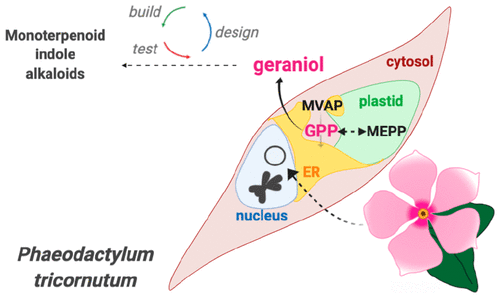当前位置:
X-MOL 学术
›
ACS Synth. Biol.
›
论文详情
Our official English website, www.x-mol.net, welcomes your
feedback! (Note: you will need to create a separate account there.)
Extrachromosomal Genetic Engineering of the Marine Diatom Phaeodactylum tricornutum Enables the Heterologous Production of Monoterpenoids.
ACS Synthetic Biology ( IF 3.7 ) Pub Date : 2020-02-19 , DOI: 10.1021/acssynbio.9b00455 Michele Fabris 1, 2 , Jestin George 1 , Unnikrishnan Kuzhiumparambil 1 , Caitlin A Lawson 1 , Ana Cristina Jaramillo-Madrid 1 , Raffaela M Abbriano 1 , Claudia E Vickers 2, 3 , Peter Ralph 1
ACS Synthetic Biology ( IF 3.7 ) Pub Date : 2020-02-19 , DOI: 10.1021/acssynbio.9b00455 Michele Fabris 1, 2 , Jestin George 1 , Unnikrishnan Kuzhiumparambil 1 , Caitlin A Lawson 1 , Ana Cristina Jaramillo-Madrid 1 , Raffaela M Abbriano 1 , Claudia E Vickers 2, 3 , Peter Ralph 1
Affiliation

|
Geraniol is a commercially relevant plant-derived monoterpenoid that is a main component of rose essential oil and used as insect repellent. Geraniol is also a key intermediate compound in the biosynthesis of the monoterpenoid indole alkaloids (MIAs), a group of over 2000 compounds that include high-value pharmaceuticals. As plants naturally produce extremely small amounts of these molecules and their chemical synthesis is complex, industrially sourcing these compounds is costly and inefficient. Hence, microbial hosts suitable to produce MIA precursors through synthetic biology and metabolic engineering are currently being sought. Here, we evaluated the suitability of a eukaryotic microalga, the marine diatom Phaeodactylum tricornutum, for the heterologous production of monoterpenoids. Profiling of endogenous metabolism revealed that P. tricornutum, unlike other microbes employed for industrial production of terpenoids, accumulates free pools of the precursor geranyl diphosphate. To evaluate the potential for larger synthetic biology applications, we engineered P. tricornutum through extrachromosomal, episome-based expression, for the heterologous biosynthesis of the MIA intermediate geraniol. By profiling the production of geraniol resulting from various genetic and cultivation arrangements, P. tricornutum reached the maximum geraniol titer of 0.309 mg/L in phototrophic conditions. This work provides (i) a detailed analysis of P. tricornutum endogenous terpenoid metabolism, (ii) a successful demonstration of extrachromosomal expression for metabolic pathway engineering with potential gene-stacking applications, and (iii) a convincing proof-of-concept of the suitability of P. tricornutum as a novel production platform for heterologous monoterpenoids, with potential for complex pathway engineering aimed at the heterologous production of MIAs.
中文翻译:

海洋硅藻Phaeodactylum tricornutum的染色体外遗传工程能够实现异源单萜的生产。
香叶醇是商业上相关的植物来源的单萜类化合物,它是玫瑰精油的主要成分,并用作驱虫剂。香叶醇也是单萜类吲哚生物碱(MIA)生物合成中的关键中间化合物,MIA是一类包括高价值药物在内的2000多种化合物。由于植物天然产生极少量的这些分子,并且它们的化学合成非常复杂,因此工业上采购这些化合物既昂贵又效率低下。因此,目前正在寻找适合通过合成生物学和代谢工程产生MIA前体的微生物宿主。在这里,我们评估了真核微藻,海洋硅藻Phaeodactylum tricornutum,对于异源生产单萜的适用性。内源性代谢分析显示P. 与用于萜类化合物工业生产的其他微生物不同,三角锥菌会积聚前体香叶基二磷酸香叶酯的自由池。为了评估更大的合成生物学应用的潜力,我们通过染色体外的,基于附加体的表达工程化了角果疟原虫,以用于MIA中间体香叶醇的异源生物合成。通过分析各种遗传和栽培安排产生的香叶醇产量,三角腐霉在光养条件下的最大香叶醇效价达到0.309 mg / L。这项工作提供(i)角果疟原虫内源性萜类化合物代谢的详细分析,(ii)染色体外表达成功用于具有潜在基因堆叠应用的代谢途径工程,以及(iii)令人信服的概念证明P的适用性。
更新日期:2020-02-20
中文翻译:

海洋硅藻Phaeodactylum tricornutum的染色体外遗传工程能够实现异源单萜的生产。
香叶醇是商业上相关的植物来源的单萜类化合物,它是玫瑰精油的主要成分,并用作驱虫剂。香叶醇也是单萜类吲哚生物碱(MIA)生物合成中的关键中间化合物,MIA是一类包括高价值药物在内的2000多种化合物。由于植物天然产生极少量的这些分子,并且它们的化学合成非常复杂,因此工业上采购这些化合物既昂贵又效率低下。因此,目前正在寻找适合通过合成生物学和代谢工程产生MIA前体的微生物宿主。在这里,我们评估了真核微藻,海洋硅藻Phaeodactylum tricornutum,对于异源生产单萜的适用性。内源性代谢分析显示P. 与用于萜类化合物工业生产的其他微生物不同,三角锥菌会积聚前体香叶基二磷酸香叶酯的自由池。为了评估更大的合成生物学应用的潜力,我们通过染色体外的,基于附加体的表达工程化了角果疟原虫,以用于MIA中间体香叶醇的异源生物合成。通过分析各种遗传和栽培安排产生的香叶醇产量,三角腐霉在光养条件下的最大香叶醇效价达到0.309 mg / L。这项工作提供(i)角果疟原虫内源性萜类化合物代谢的详细分析,(ii)染色体外表达成功用于具有潜在基因堆叠应用的代谢途径工程,以及(iii)令人信服的概念证明P的适用性。











































 京公网安备 11010802027423号
京公网安备 11010802027423号